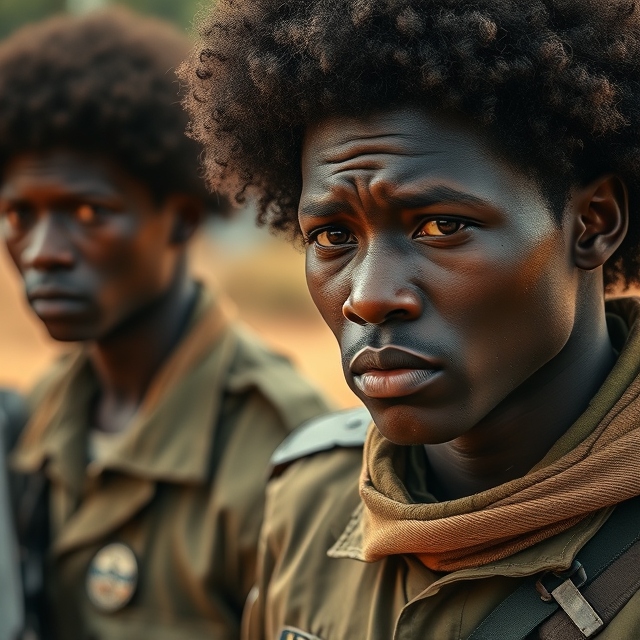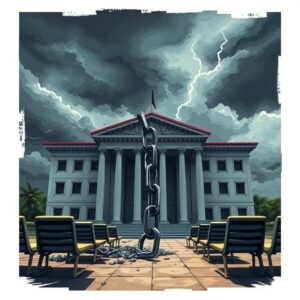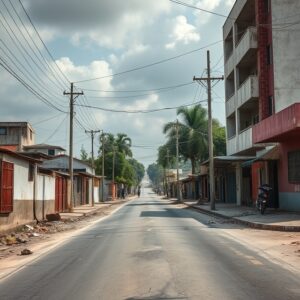Stories from the Nigerian Civil War: Voices of the Past

Scene showing soldiers in the rural Nigerian Civil War environment, conveying fear, sorrow, and determination. Al Image.
Voices of the Past: Stories from the Nigerian Civil War
The war began in 1967, a complex and harrowing conflict rooted in political, economic, and ethnic divisions. It came with devastating consequences, forever shaping Nigeria and its people. This was a time when alliances crumbled, ambitions clashed, and entire communities found themselves caught in the crossfire. The Nigerian Civil War—known as the Biafran War—ripped through families, towns, and lives with heartbreaking finality.
The war began on July 6, 1967, when Nigerian forces moved to suppress the secessionist ambitions of the Eastern Region. This was the result of a series of political and social issues that had escalated after Nigeria gained independence in 1960. The Eastern Region, predominantly Igbo in ethnicity, sought self-rule and declared independence as the Republic of Biafra. This declaration, led by Colonel Odumegwu Ojukwu, set the stage for the devastating conflict that would follow.
Before the conflict erupted, Nigeria had already faced a series of divisive events, including political instability and violence. The military, with its influence over civilian governance, played a major role in the build-up to the war. Colonel Ojukwu’s declaration of independence came as the Eastern Region felt marginalized by the federal government. The tensions boiled over into open warfare as federal troops advanced toward the region, aiming to stop the secession.
As Nigerian federal forces advanced, families were forced to make heartbreaking decisions. Many fled their homes as the sounds of approaching soldiers grew louder. The Eastern Region became a hotbed of fear and anger as thousands of civilians scrambled to protect themselves. Families that had once lived in peaceful villages now found themselves in refugee camps or unfamiliar surroundings. The stories of those forced to leave their homes are woven into the accounts of the war’s devastation.
For soldiers, the war was both a call to arms and a complex struggle of shifting alliances. Nigerian federal troops moved swiftly to block the Eastern Region’s escape routes, aiming to cut off supplies and reinforcements. Within the ranks, soldiers often found themselves grappling with the complexities of fighting a war that was not just about geography but about ethnicity, politics, and economic control. Many federal soldiers had no personal grievances against the people they fought but were driven by orders from the federal government.
Among the key figures in the war was General Yakubu Gowon, who led Nigeria’s military during the conflict. Gowon’s leadership was critical in the federal government’s efforts to suppress Biafran ambitions, but his role was also shaped by the challenge of navigating military pressure and international concerns. General Gowon focused on maintaining the integrity of the Nigerian state while attempting to minimize civilian casualties. His strategy involved military occupation, blockades, and counter-insurgency tactics.
In Biafra, Colonel Odumegwu Ojukwu became the face of resistance. His vision for Biafra was simple: for the Igbo people to govern themselves without interference from the central Nigerian government. Ojukwu garnered support from local communities, intellectuals, and the Eastern population, who saw the secession as a means of survival. Ojukwu’s leadership was instrumental in uniting his people and holding the secessionist effort together, even as supplies and resources grew scarce.
The war itself was brutal. The Nigerian federal government implemented a blockade on Biafra, hoping to cut off supplies, food, and arms to the secessionists. The effects of this blockade were devastating. Food shortages led to widespread starvation, especially in Biafra, where families were struggling to survive with limited supplies. Reports of famine became a horrifying feature of the war, as children and entire families starved in their attempt to escape the violence or find food. The suffering was evident, and relief organizations scrambled to help, though their efforts were hampered by the violence.
Refugee camps became overcrowded as thousands of civilians fled the fighting. Families found themselves displaced, their homes destroyed, their livelihoods taken. Those in the camps struggled with disease, hunger, and trauma. Relief organizations and NGOs, including the Red Cross and other international groups, mobilized to aid the displaced, but the suffering was widespread and difficult to address given the challenges of war.
The Nigerian federal government also faced challenges on the international front. Several countries, particularly Britain, the United States, and other powers with economic and political interests in Nigeria, debated whether to intervene directly in the conflict. Some nations supported the federal government’s actions, while others sympathized with the Biafran secessionists. The complexities of these international relations added another layer to the war. The debate over how to balance humanitarian aid with political alliances played out in diplomatic corridors as millions of Nigerians continued to suffer.
Amid the chaos, soldiers on both sides experienced the horrors of combat. The terrain was unforgiving, and every village taken came at a heavy cost. The federal government employed harsh military tactics to ensure control over the region, while Biafran troops conducted guerrilla-style attacks, often targeting supply lines or convoys. These actions created a pattern of violence that resulted in widespread suffering among civilians. Soldiers sometimes faced starvation, sickness, and psychological exhaustion, with many losing the will to fight as they watched the toll of war mount.
One of the many tragic stories from this time comes from the children caught in the middle of the war. Many children were orphaned as a result of the fighting. Entire villages were wiped out, and families could no longer support their own as the conflict spread. Relief workers noted that children, separated from their parents, were among the most vulnerable during the war. The humanitarian crisis in Biafra highlighted how wars destroy the most vulnerable—children without access to food, medicine, or even shelter.
By 1970, the war had taken its toll. Starvation, military strategy, and the determination of both the federal government and Biafran forces had led to overwhelming losses on both sides. Ojukwu’s resistance ultimately crumbled as Biafran forces could no longer sustain themselves. After years of intense fighting and suffering, Biafra surrendered in January 1970. The war had lasted approximately three years and claimed the lives of an estimated one to three million people, though the true number of casualties remains uncertain.
The surrender came as Ojukwu fled into exile, and Nigerian troops took control of the final territories held by the secessionists. The conflict left deep scars on the Nigerian people and their history. The aftermath of the war saw families grieving, survivors struggling to rebuild their lives, and a country trying to heal from the divisions created by the conflict. While the war ended militarily, its effects lingered for decades as Nigeria wrestled with the aftermath of violence and political upheaval.
The voices of the war’s survivors continue to resonate, and many have worked to preserve the history of their experiences. These accounts—the voices of children who lost their parents, soldiers who fought on both sides, families torn apart by violence—are a reminder of how war leaves no one untouched. As Nigeria reflects on its history, the stories from the Nigerian Civil War continue to stand as a reminder of the consequences of division, power, and ambition.
The Nigerian Civil War may have ended over fifty years ago, but its echoes remain. These stories from the past speak to a time of unimaginable pain, and remembering them ensures that the sacrifices and suffering are never forgotten.





